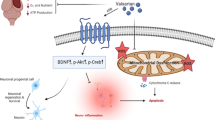Abstract
Omega-3 polyunsaturated fatty acids (n-3 PUFAs) exert therapeutic potential in a variety of neurological disorders, including ischemic stroke. However, the underlying mechanisms still lack investigation. Here, we report that cultured cortical neurons isolated from fat-1 mice with high endogenous n-3 PUFAs were tolerant to oxygen-glucose deprivation/reperfusion (OGD/R) injury. Fat-1 neurons exhibited significantly attenuated reactive oxygen species (ROS) activation induced by OGD/R injury, upregulated antiapoptotic proteins Bcl-2 and Bcl-xL, and reduced cleaved caspase-3. Exogenous administration of docosahexaenoic acid (DHA), a major component of the n-3 PUFA family, resulted in similar protective effects on cultured cortex neurons. We further verified the protective effects of n-3 PUFAs in vivo, using a mini ischemic model with a reproducible cortical infarct and manifest function deficits by occlusion of the distal branch of the middle cerebral artery with focused femtosecond laser pulses. The Fat-1 animals showed decreased ROS expression and higher level of glutathione in the injured brain, associated with improved functional recovery. We therefore provide evidence that n-3 PUFAs exert their protective effects against ischemic injury both in vitro and in vivo, partly through inhibiting ROS activation.






Similar content being viewed by others
References
Stankowski JN, Gupta R (2011) Therapeutic targets for neuroprotection in acute ischemic stroke: lost in translation? Antioxid Redox Signal 14:1841–1851
Broughton BR, Reutens DC, Sobey CG (2009) Apoptotic mechanisms after cerebral ischemia. Stroke 40:e331–e339
Belayev L, Khoutorova L, Atkins KD, Eady TN, Hong S, Lu Y et al (2011) Docosahexaenoic acid therapy of experimental ischemic stroke. Transl Stroke Res 2:33–41
Belayev L, Khoutorova L, Atkins KD, Bazan NG (2009) Robust docosahexaenoic acid-mediated neuroprotection in a rat model of transient, focal cerebral ischemia. Stroke 40:3121–3126
Hong SH, Belayev L, Khoutorova L, Obenaus A, Bazan NG (2014) Docosahexaenoic acid confers enduring neuroprotection in experimental stroke. J Neurol Sci 338:135–141
Bazan NG (2007) Omega-3 fatty acids, pro-inflammatory signaling and neuroprotection. Curr Opin Clin Nutr Metab Care 10:136–141
Bazan NG, Marcheselli VL, Cole-Edwards K (2005) Brain response to injury and neurodegeneration: endogenous neuroprotective signaling. Ann N Y Acad Sci 1053:137–147
Zhang MJ, Spite M (2012) Resolvins: anti-inflammatory and proresolving mediators derived from omega-3 polyunsaturated fatty acids. Annu Rev Nutr 32:203–227
Kichev A, Rousset CI, Baburamani AA, Levison SW, Wood TL, Gressens P et al (2014) TNF-related apoptosis-inducing ligand (TRAIL) signaling and cell death in the immature central nervous system after hypoxia-ischemia and inflammation. J Biol Chem
Eady TN, Khoutorova L, Obenaus A, Mohd-Yusof A, Bazan NG, Belayev L (2014) Docosahexaenoic acid complexed to albumin provides neuroprotection after experimental stroke in aged rats. Neurobiol Dis 62:1–7
Eady TN, Khoutorova L, Anzola DV, Hong SH, Obenaus A, Mohd-Yusof A et al (2013) Acute treatment with docosahexaenoic acid complexed to albumin reduces injury after a permanent focal cerebral ischemia in rats. PLoS One 8, e77237
Williams JJ, Mayurasakorn K, Vannucci SJ, Mastropietro C, Bazan NG, Ten VS et al (2013) N-3 fatty acid rich triglyceride emulsions are neuroprotective after cerebral hypoxic-ischemic injury in neonatal mice. PLoS One 8, e56233
Eady TN, Belayev L, Khoutorova L, Atkins KD, Zhang C, Bazan NG (2012) Docosahexaenoic acid signaling modulates cell survival in experimental ischemic stroke penumbra and initiates long-term repair in young and aged rats. PLoS One 7, e46151
Marcheselli VL, Hong S, Lukiw WJ, Tian XH, Gronert K, Musto A et al (2003) Novel docosanoids inhibit brain ischemia-reperfusion-mediated leukocyte infiltration and pro-inflammatory gene expression. J Biol Chem 278:43807–43817
Tan Y, Ren H, Shi Z, Yao X, He C, Kang JX et al (2015) Endogenous docosahexaenoic acid (DHA) prevents Abeta1-42 oligomer-induced neuronal injury. Mol Neurobiol
Go AS, Mozaffarian D, Roger VL, Benjamin EJ, Berry JD, Blaha MJ et al (2014) Heart disease and stroke statistics--2014 update: a report from the American Heart Association. Circulation 129:e28–e292
Doyle KP, Simon RP, Stenzel-Poore MP (2008) Mechanisms of ischemic brain damage. Neuropharmacology 55:310–318
Kirkland RA, Windelborn JA, Kasprzak JM, Franklin JL (2002) A Bax-induced pro-oxidant state is critical for cytochrome c release during programmed neuronal death. J Neurosci 22:6480–6490
Sugawara T, Chan PH (2003) Reactive oxygen radicals and pathogenesis of neuronal death after cerebral ischemia. Antioxid Redox Signal 5:597–607
Janaky R, Ogita K, Pasqualotto BA, Bains JS, Oja SS, Yoneda Y et al (1999) Glutathione and signal transduction in the mammalian CNS. J Neurochem 73:889–902
Bouet V, Boulouard M, Toutain J, Divoux D, Bernaudin M, Schumann-Bard P et al (2009) The adhesive removal test: a sensitive method to assess sensorimotor deficits in mice. Nat Protoc 4:1560–1564
Chen YJ, Cheng FC, Sheu ML, Su HL, Chen CJ, Sheehan J et al (2014) Detection of subtle neurological alterations by the catwalk XT gait analysis system. J Neuroeng Rehabil 11:62
Loh KP, Huang SH, De Silva R, Tan BK, Zhu YZ (2006) Oxidative stress: apoptosis in neuronal injury. Curr Alzheimer Res 3:327–337
Belayev L, Marcheselli VL, Khoutorova L, de Turco Rodriguez EB, Busto R, Ginsberg MD et al (2005) Docosahexaenoic acid complexed to albumin elicits high-grade ischemic neuroprotection. Stroke 36:118–123
Acknowledgments
This study was supported by the Macao Science and Technology Development Fund (018/2013/A1), matching grant project MRG003/SHX/2014/ICMS, and multi-year research grant, University of Macau, MYRG122 (Y1-L3)-ICMS12-SHX and MYRG110 (Y1-L2)-ICMS13-SHX. The work was also supported by the “Hundred Talents program,” “Qing Lan Project” of Nanjing Normal University, Jiangsu Provincial Natural Science Foundation (#BK20140917), and National Natural Science Foundation of China (#81501164).
Author Contributions
ZS, HR, CL, XY, PL, CH, TY, and HS designed and performed the study; ZS, HR, CL, JK, JW, TY, and HS analyzed the results; and all authors wrote the draft together and approved the final version.
Author information
Authors and Affiliations
Corresponding authors
Ethics declarations
Conflict of Interest
The authors declared no conflicts of interest.
Rights and permissions
About this article
Cite this article
Shi, Z., Ren, H., Luo, C. et al. Enriched Endogenous Omega-3 Polyunsaturated Fatty Acids Protect Cortical Neurons from Experimental Ischemic Injury. Mol Neurobiol 53, 6482–6488 (2016). https://doi.org/10.1007/s12035-015-9554-y
Received:
Accepted:
Published:
Issue Date:
DOI: https://doi.org/10.1007/s12035-015-9554-y




